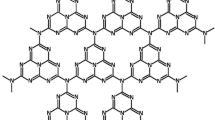Abstract
Here focusing on the very new experimental finding on carbon nanomaterials for solid-state electron mediator applications in Z-scheme photocatalysis, we have investigated different graphene-based nanostructures chemisorbed by various types and amounts of species such as oxygen (O), nitrogen (N) and hydroxyl (OH) and their electronic structures using density functional theory. The work functions of different nanostructures have also been investigated by us to evaluate their potential applications in Z-scheme photocatalysis for water splitting. The N-, O–N-, and N–N-chemisorbed graphene-based nanostructures (32 carbon atoms supercell, corresponding to lattice parameter of about 1 nm) are found promising to be utilized as electron mediators between reduction level and oxidation level of water splitting. The O- or OH-chemisorbed nanostructures have potential to be used as electron conductors between H2-evolving photocatalysts and the reduction level (H+/H2). This systematic study is proposed to understand the properties of graphene-based carbon nanostructures in Z-scheme photocatalysis and guide experimentalists to develop better carbon-based nanomaterials for more efficient Z-scheme photocatalysis applications in the future.







Similar content being viewed by others
References
Blöchl PE (1994) Projector augmented-wave method. Phys Rev B 50:17953–17979
Chakrapani V, Angus JC, Anderson AB, Wolter SD, Stoner BR, Sumanasekera GU (2007) Charge transfer equilibria between diamond and an aqueous oxygen electrochemical redox couple. Science 318:1424–1430
Chen XB, Shen SH, Guo LJ, Mao SS (2010) Semiconductor-based photocatalytic hydrogen generation. Chem Rev 110:6503–6570
Dreyer DR, Park S, Bielawski CW, Ruoff RS (2010) The chemistry of graphene oxide. Chem Soc Rev 39:228–240
Fu N, Jin Z, Wu Y, Lu G, Li D (2011) Z-scheme photocatalytic system utilizing separate reaction centers by directional movement of electrons. J Phys Chem C 115:8586–8593
Fujishima A, Honda K (1972) Electrochemical photolysis of water at a semiconductor electrode. Nature 238:37–38
Gao W, Alemany LB, Ci L, Ajayan PM (2009) New insights into the structure and reduction of graphite oxide. Nat Chem 1:403–408
Gao W, Singh N, Song L, Liu Z, Reddy ALM, Ci L, Vajtai R, Zhang Q, Wei B, Ajayan PM (2011) Direct laser writing of micro-supercapacitors on hydrated graphite oxide films. Nat Nanotechnol 6:496–500
Grätzel M (1983) Energy resources through photochemistry and catalysis. Academic Press, New York
Hoffmann MR, Martin ST, Choi W, Bahnemann DW (1995) Environmental applications of semiconductor photocatalysis. Chem Rev 95:69–96
Hohenberg P, Kohn W (1964) Inhomogeneous electron gas. Phys Rev 136:B864–B871
Iwase A, Ng YH, Ishiguro Y, Kudo A, Amal R (2011) Reduced graphene oxide as a solid-state electron mediator in Z-scheme photocatalytic water splitting under visible light. J Am Chem Soc 133:11054–11057
Kajita S, Nakayama T, Yamauchi J (2006) Density functional calculation of work function using charged slab systems. J Phys Conf Ser 29:120–123
Kohn W, Sham LJ (1965) Self-consistent equations including exchange and correlation effects. Phys Rev 140:A1133–A1138
Kresse G, Furthmüller J (1996) Efficient iterative schemes for ab initio total-energy calculations using a plane-wave basis set. Phys Rev B 54:11169–11186
Kresse G, Hafner J (1993) Ab initio molecular dynamics for open-shell transition metals. Phys Rev B 48:13115–13118
Kudo A (2007) Photocatalysis and solar hydrogen production. Pure Appl Chem 79:1917–1927
Kudo A (2011) Z-scheme photocatalyst systems for water splitting under visible light irradiation. MRS Bull 36:32–38
Kudo A, Miseki Y (2009) Heterogeneous photocatalyst materials for water splitting. Chem Soc Rev 38:253–278
Lewis NS, Nocera DG (2006) Powering the planet: chemical challenges in solar energy utilization. Proc Natl Acad Sci USA 103:15729–15735
Lightcap IV, Kosel TH, Kamat PV (2010) Anchoring semiconductor and metal nanoparticles on a two-dimensional catalyst mat. storing and shuttling electrons with reduced graphene oxide. Nano Lett 10:577–583
Maeda K, Domen K (2007) New non-oxide photocatalysts designed for overall water splitting under visible light. J Phys Chem C 111:7851–7861
Perdew JP, Chevary JA, Vosko SH, Jackson KA, Pederson MR, Singh DJ, Fiolhais C (1992) Atoms, molecules, solids, and surfaces: applications of the generalized gradient approximation for exchange and correlation. Phys Rev B 46:6671–6687
Sasaki Y, Nemoto H, Saito K, Kudo A (2009) Solar water splitting using powdered photocatalysis driven by Z-schematic interparticle electron transfer with an electron mediator. J Phys Chem C 113:17536–17542
Suwanchawalit C, Wongnawa S (2010) Triblock copolymer-templated synthesis of porous TiO2 and its photocatalytic activity. J Nanopart Res 12:2895–2906
Turner JA (1999) A realizable renewable energy future. Science 285:687–689
Wang L, Lee K, Sun YY, Lucking M, Chen Z, Zhao JJ, Zhang S (2009) Graphene oxide as an ideal substrate for hydrogen storage. ACS Nano 10:2995–3000
Xiang Q, Yu J, Jaroniec M (2012) Graphene-based semiconductor photocatalysts. Chem Soc Rev 41:782–796
Yeh TF, Chan FF, Hsieh CT, Teng H (2011) Graphite oxide with different oxygenated levels for hydrogen and oxygen production from water under illumination: the band positions of graphite oxide. J Phys Chem C 115:22587–22597
Acknowledgments
We would like to acknowledge FORMAS, Wenner-Gren Foundations, the Swedish Research Council (VR), the Swedish Foundation for International Cooperation in Research and Higher Education (STINT), the China Scholarship Council and the Higher Education Commission of Pakistan for financial supports. The Swedish National Infrastructure for Computing (SNIC), the Uppsala Multidisciplinary Center for Advanced Computational Science (UPPMAX) and National Supercomputer Centre (NSC) are acknowledged for providing computing time for this project.
Author information
Authors and Affiliations
Corresponding authors
Additional information
This article is part of the topical collection on nanomaterials in energy, health and environment
Rights and permissions
About this article
Cite this article
Qian, Z., Pathak, B., Nisar, J. et al. Oxygen- and nitrogen-chemisorbed carbon nanostructures for Z-scheme photocatalysis applications. J Nanopart Res 14, 895 (2012). https://doi.org/10.1007/s11051-012-0895-4
Received:
Accepted:
Published:
DOI: https://doi.org/10.1007/s11051-012-0895-4




